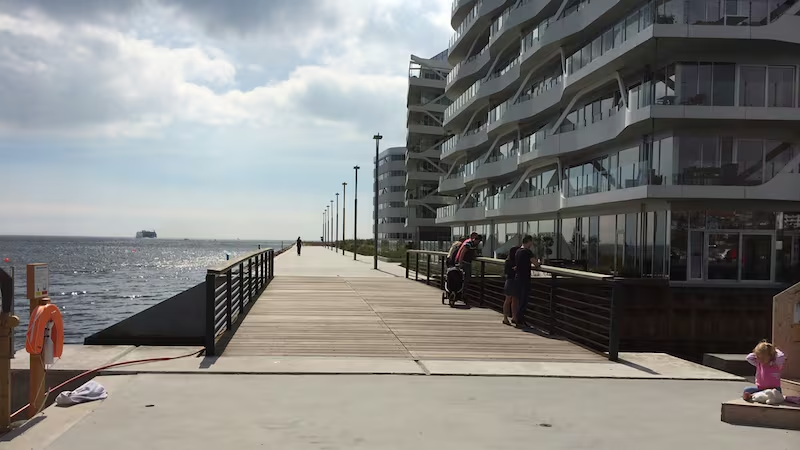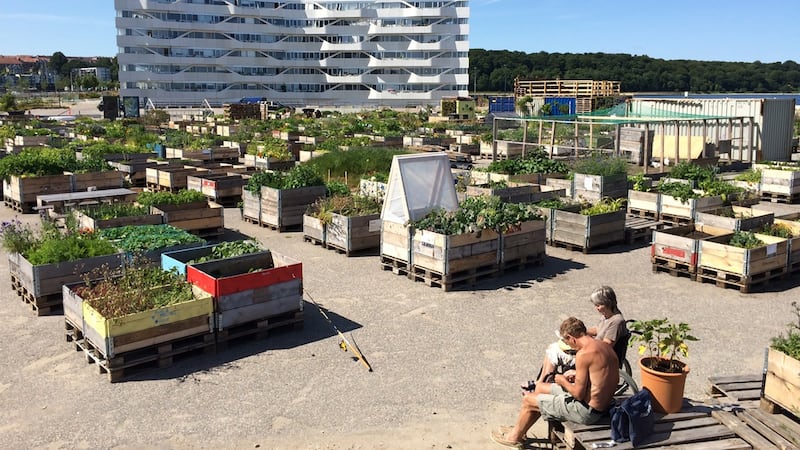One of the best views in Aarhus is from one of the new apartments overlooking the redeveloped harbour. You can pay handsomely for the privilege - over €5,000 per sq m, half a million euro to buy a 100sq m flat; or, for a slightly smaller three-room apartment, you might pay a monthly rent of 8000 kronor, just over €1,100.
This is the public-private housing reality in Aarhus, Denmark’s second city, thanks to far-sighted public housing laws a century ago.
Deeply rooted in the Danish mentality is the conviction that housing is more than a commodity, and that high-quality public housing is the key to social peace, not simply shoddy boxes for poor people.
For most of the past decade, a period of tremendous transformation in the city, Aarhus entrusted the task of preserving and rethinking this social inheritance to British-born architect Stephen Willacy. One of his priorities in his non-political role was to make clear to commercial and residential developers that it is a privilege to build in Aarhus and that, if they are lucky enough to be granted this privilege, they will be in service to the city and its residents – and not the other way around.
"I often see myself as piggy in the middle, a steward for the city council," says Willacy, who has lived in Denmark since 1984. "Investors often come in with ideas from the outside, particularly on optimum square metre space – but we're very concerned with how it will fit into the city environment."

This novel approach was the subject of a recent address by Willacy at an industry conference in Dublin organised by the Society of Chartered Surveyors Ireland and co-hosted with architects, engineers and planners.
On Willacy’s watch, Aarhus put the citizen cart before the developer horse with remarkable results. A new cityscape has arisen, attracting some of the biggest names in Danish and international architecture, but always with locals in mind.
Before anyone gets to build anything in Aarhus, potential developers were asked to engage with Willacy and the planning office to first discuss the space in which the final buildings will stand. The question to be clarified before the first sod was turned: what is your project going to give back to the city? To concentrate minds, developers with the best ideas knew they would get first dibs on the available sites when they were released for sale.
“It took a while to get the developers and builders to meet this head on. They thought this was just a phase, but then they realised ‘we have to do this now’ because I had political backing,” said Willacy. “We put people first, and they want high-quality urban areas, so this has become our business-as-usual dialogue with developers.”
Having such a sustainable, resident-led approach to development is a logical outgrowth from the wider political culture in Denmark, which is built on political consensus.
Political consensus
Seven parties sit in Aarhus city council but, whether in power or opposition, all have a say in large-scale projects such as a light rail project or the harbour redevelopment. The latter plan was agreed at the turn of this century and, with regular tweaks, is still being worked through – regardless of the four-year political calendar. For Willacy, this has created planning perspectives based on consistency and continuity rather than short-term political priorities.
“We don’t stop and start, as you see in other cities; the work goes on,” he said. “The reason why we are allowed do projects like these is because of strong governance and stewardship of planning.”
This political consensus culture has several non-negotiables, chief of which is a public housing system that is open to all, not just those on low incomes. It was created with the 1919 social housing act when, similar to other European countries after the first World War, Danish authorities prioritised a non-profit housing sector in which residents influence their living conditions through so-called “tenants’ democracy”.
Across Denmark, around 760 housing associations control over half a million public housing units. As elsewhere in the country, private sector housing in Aarhus competes with the non-profit sector controlled by around a dozen public housing associations. This set-up couldn’t be further from the reality of – or mentality toward – social housing in the UK and Ireland, still shaped by the Thatcher era.
Danish housing associations are non-profit and two-thirds of the rent collected goes into a national building foundation, where the mortgage loan is paid off. As mortgages are cleared, the rental income pot can be used to finance new social housing or renovate existing stock. In Aarhus, this has allowed housing associations upgrade their stock to modern energy standards without corresponding rent increases.

“This could be a great export because it works very well in 48,000 homes in Aarhus, for a population of 360,000,” says Willacy.
Recent years have seen new pressures on this system in Aarhus, with a population rise of 5,000 annually and a jump in land prices prompting the city council to insist that a quarter of all new housing built be reserved for public housing. Such tenant-friendly regulations, combined with rules penalising quick resales of residential property, have helped clip the wings of investment funds seeking fast profits.
In Aarhus, public housing is not just about managing historical housing stock, but adding to it. One of Willacy’s tasks in his term was to co-ordinate City Hall and the housing associations to build 1,600 public housing units over a three-year period. As part of the plan, he encouraged housing associations to run mini architectural projects to get the best, new thinking for the finished housing units.
Social mix
Like elsewhere in Denmark, the public housing system in Aarhus is not strictly means-based but list-based: you put your name on a list, every year you rise up the list and the housing offers improve.
This system has struggled in recent years in major Danish cities because of ongoing housing shortages. It can be abused, too, with complicated sublet chains as people cling to their housing association flat even if they live elsewhere.

But Willacy is confident the abuses are minor compared with the benefits of a system that he says creates a healthy social mix rather than social housing ghettos.
As well as attracting a cross-section of the population, residents have direct control of their housing management by electing tenant boards and meeting annually to approve rent and refurbishment works. In addition, an appeals board acts as a dispute resolution mechanism between tenants and housing associations.
Looking back after nearly nine years as chief architect in Aarhus, Willacy is particularly proud of how he took a century-old, people-centred public housing model and applied it to the wider city with what he calls the Aarhus “procurement model”. This front-loads citizen involvement in all new planning, resulting in real co-creation between developers and citizens.
“It is slower at the start but when we submit the plan, politically, it is an easy ride,” he says. “There is no quick fix in city planning. The quick fix doesn’t work if you want everyone on board.”











